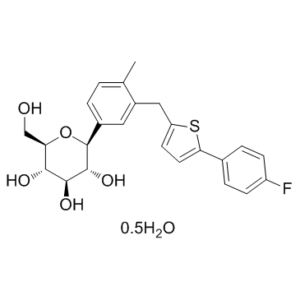Canagliflozin hemihydrate (JNJ 28431754)
This product is for research use only, not for human use. We do not sell to patients.

For small sizes, please check our retail website as below: www.invivochem.com
| Size | Price | Stock |
|---|---|---|
| 1g | $250 | In Stock |
| 2g | $400 | In Stock |
| 5g | $660 | In Stock |
Cat #: V3978 CAS #: 928672-86-0 Purity ≥ 98%
Description: Canagliflozin hemihydrate (also known as TA-7284; JNJ-24831754ZAE; JNJ 28431754AAA; JNJ-28431754; Invokana), the hemihydrated form of Canagliflozin, is a highly potent and selective SGLT2 inhibitor with anti-diabetic effects.
Top Publications Citing Invivochem Products
Publications Citing InvivoChem Products
Product Promise

- Physicochemical and Storage Information
- Protocol
- Related Biological Data
- Stock Solution Preparation
- Quality Control Documentation
| Molecular Weight (MW) | 907.05 |
|---|---|
| Molecular Formula | C48H52F2O11S2 |
| CAS No. | 928672-86-0 |
| Storage | -20℃ for 3 years in powder formr |
| -80℃ for 2 years in solvent | |
| Solubility In Vitro | DMSO: >100 mg/mLr |
| Water: <1 mg/mLr | |
| Ethanol: >100 mg/mL | |
| Solubility In Vivo | 0.5% CMC+0.25% Tween 80: 18 mg/mL |
| Synonyms | JNJ 28431754 hemihydrate; TA-7284 hemihydrate; JNJ 24831754; TA7284; JNJ-24831754; JNJ24831754AAA hemihydrate; JNJ24831754ZAE; TA 7284; |
| Protocol | In Vitro | Canagliflozin inhibits Na+-dependent 14C-AMG uptake in CHO-hSGLT2 cells, with an IC50 of 4.4±1.2 nM. Similar IC50 values are obtained in CHO-rSGLT2 and CHO-mSGLT2 cells (IC50 = 3.7 and 2.0 nM for rat and mouse SGLT2, respectively). Canagliflozin inhibits 14C-AMG uptake in CHO-hSGLT1 and mSGLT1 cells with IC50 of 684±159 nM and >1,000 nM, respectively |
|---|---|---|
| In Vivo | Canagliflozin (30 mg/kg treatment for 4 weeks) reduced blood glucose (BG) levels, respiratory exchange ratio, and body weight gain in DIO mice[1]. Canagliflozin (3 mg/kg for 3 weeks) increases urinary glucose excretion (UGE) with no significant change in total food intake compared with that in vehicle-treated rats, leading to a decrease in body weight In ZF rats | |
| Animal model | Diet-induced obese, insulin resistantmice (DIO) Mice | |
| Dosages | 30 mg/kg | |
| Administration | Oral gavage; daily; 4 weeks |
These protocols are for reference only. InvivoChem does not
independently validate these methods.
| Solvent volume to be added | Mass (the weight of a compound) | |||
|---|---|---|---|---|
| Mother liquor concentration | 1mg | 5mg | 10mg | 20mg |
| 1mM | 1.1025 mL | 5.5124 mL | 11.0248 mL | 22.0495 mL |
| 5mM | 0.2205 mL | 1.1025 mL | 2.2050 mL | 4.4099 mL |
| 10mM | 0.1102 mL | 0.5512 mL | 1.1025 mL | 2.2050 mL |
| 20mM | 0.0551 mL | 0.2756 mL | 0.5512 mL | 1.1025 mL |
The molarity calculator equation
Mass(g) = Concentration(mol/L) × Volume(L) × Molecular Weight(g/mol)
Mass
=
Concentration
×
Volume
×
Molecular Weight*
The dilution calculator equation
Concentration(start)
×
Volume(start)
=
Concentration(final)
×
Volume(final)
This equation is commonly abbreviated as: C1 V1 = C2 V2
Concentration(start)
C1
×
Volume(start)
V1
=
Concentration(final)
C2
×
Volume(final)
V2
Step One: Enter information below
Dosage mg/kg
Average weight of animals g
Dosing volume per animal µL
Number of animals
Step Two: Enter the in vivo formulation
%DMSO
+
%
+
%Tween 80
+
%ddH2O
Calculation Results:
Working concentration:
mg/ml;
Method for preparing DMSO master liquid:
mg
drug pre-dissolved in
µL
DMSO(Master liquid concentration
mg/mL)
,Please contact us first if the concentration exceeds the DMSO solubility of the batch of drug.
Method for preparing in vivo formulation:
Take
µL
DMSO master liquid, next add
µL
PEG300, mix and clarify, next add
µL
Tween 80,mix and clarify, next add
µL
ddH2O,mix and clarify.
Note:
- (1) Please be sure that the solution is clear before the addition of next solvent. Dissolution methods like vortex, ultrasound or warming and heat may be used to aid dissolving.
- (2) Be sure to add the solvent(s) in order.




































